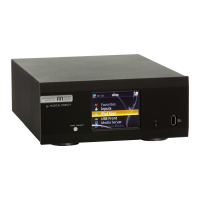
Do you have a question about the Musical Fidelity M1 Clic and is the answer not in the manual?
| USB | USB 2.0 |
|---|---|
| Type | Digital Audio Controller |
| Inputs | USB, Optical, Coaxial |
| Outputs | Optical, Coaxial |
| Supported Formats | WAV, FLAC, MP3, AAC, WMA |
| Control | Remote control, Mobile app |
| Connectivity | Ethernet, WiFi |
Details on how the M1 CLIC receives software updates via the network.
Legal information regarding "Made for iPod/iPhone" certification and standards.
Congratulates the user and describes the unit's performance capabilities.
Instructions on how to clean the unit's cabinet and remote control.
Guidance on placing the unit on a stable, horizontal surface away from vibration.
Details on connecting the M1 CLIC to the mains power supply using an IEC cable.
Explains RCA Fixed Output and RCA PRE Output connections.
Details on connecting Coaxial and Optical digital inputs.
Instructions for connecting computers and USB storage devices.
Explains the 3.5mm trigger output for switching other devices.
Instructions for connecting the unit via wired RJ45 or Wi-Fi antenna.
Overview of power button, display, IR receiver, and USB input on the front panel.
Detailed explanation of all analogue, digital, network, and output connectors on the rear.
How to use the remote control, pointing direction, and battery replacement.
Detailed explanation of each button's function on the remote control.
How to use PRE OUT and FIXED OUT for amplifier connections.
Connecting the trigger output to control other components.
Connecting analogue sources like tape decks via AUX inputs.
Connecting digital sources via Coaxial and Optical inputs.
Using the M1 CLIC as a sound card via USB.
Connecting USB drives for music playback.
Connecting iPod or iPhone for audio playback.
Connecting to a wired network using RJ45 cable.
Connecting the Wi-Fi antenna for wireless network setup.
Steps to power on the unit and initial startup sequence.
How to put the unit into low-power standby mode.
Detailed explanation of navigation, volume, and function buttons.
How to use the numeric keypad for character input.
Functionality of the repeat button for tracks or playlists.
Functionality of the shuffle button for random playback.
Setting the local time zone and daylight saving options.
Customizing language, themes, and display timeout.
Configuring repeat, shuffle, and slideshow settings.
Options for resetting settings, software updates, info, and legal notices.
Step-by-step guide for connecting via an Ethernet cable.
Guide for connecting to a Wi-Fi network, including SSID and WEP/PSK.
Overview of the internet radio function and its benefits.
Instructions on how to set up and use vTuner for custom station lists.
How to play music and pictures from a personal computer.
Options for browsing music by genre, artist, album, or composer.
How to view shared photos by date, album, or keywords.
Accessing and playing music or picture playlists.
Connecting and playing music from iPod or iPhone via the rear USB.
Playing personal playlists stored on the iPod or iPhone.
Browsing music by artist name.
Browsing music by album name.
Listing and playing all songs alphabetically.
Listing and playing podcasts.
Browsing music by genre.
Browsing music by composer.
Listing and playing audiobooks.
Connecting USB drives or hard drives to the front USB input.
Connecting mobile phones or modern devices as USB storage.
Recommended folder structure for organizing music files.
Information on supported file systems (FAT16/FAT32) for USB drives.
Overview of the seven available audio input sources.
Details on digital inputs for stereo PCM sources.
Connecting the unit to a computer as an external soundcard.
Connecting legacy analogue sources via AUX inputs.
Notes on connecting the USB DAC, drivers, and PC/Mac configuration.
Troubleshooting steps for issues with power or display.
Solutions for hum noise issues, including cable checks.
Troubleshooting digital output problems, including input selection and data type.
Resolving issues with missing or low audio output.
Troubleshooting sound dropouts from digital inputs or USB.
Steps to resolve no audio output from USB connections.
How to fix issues where USB devices are not recognized.
Technical specifications for analogue outputs and inputs.
Technical specifications for the DAC circuit and digital performance.
Details of all line level, digital, network, and trigger connections.
Specifications for mains voltage, consumption, and display type.
Lists UPnP, Internet Radio, iPod, network, and UI features.
Supported media server applications and UPnP renderers.
Support for vTuner and iRadio databases.
Specifications for MP3 audio file format.
Specifications for AAC audio file format.
Specifications for AAC+ audio file format.
Specifications for Ogg Vorbis audio file format.
Specifications for FLAC audio files, including high-resolution.
Specifications for LPCM audio files, typically WAV format.
Specifications for WMA-9 audio files.
Specifications for WMA-9 lossless and pro audio formats.
Lists UPnP, streaming, and metadata features.
Details on 10Base-T, 100Base-T, and PHY Ethernet standards.
Details on IEEE 802.11b/g, SSID, WPA, and WPS.
Lists DHCP, IP addressing, web server, and remote control protocols.
Details on USB 2.0 HS, FAT formats, and iPod/iPad modes.
Lists supported languages, character sets, and encodings.
Details on NTP, Auto DST, and real-time clock features.
Information on embedded web server and supported browsers.
Lists supported audio file containers (MP3, AAC, WAV, WMA, etc.).
Detailed specifications for MP3, AAC, Ogg Vorbis, FLAC, LPCM, and WMA codecs.
Specifications for high-resolution FLAC audio files.
Specifications for LPCM audio files, typically WAV format.
Specifications for WMA-9 audio files.
Specifications for WMA-9 lossless and pro audio formats.
Unit weight and shipping carton weight.
Physical dimensions of the unit (width, height, depth).
List of included accessories like manual, aerial, and cables.
